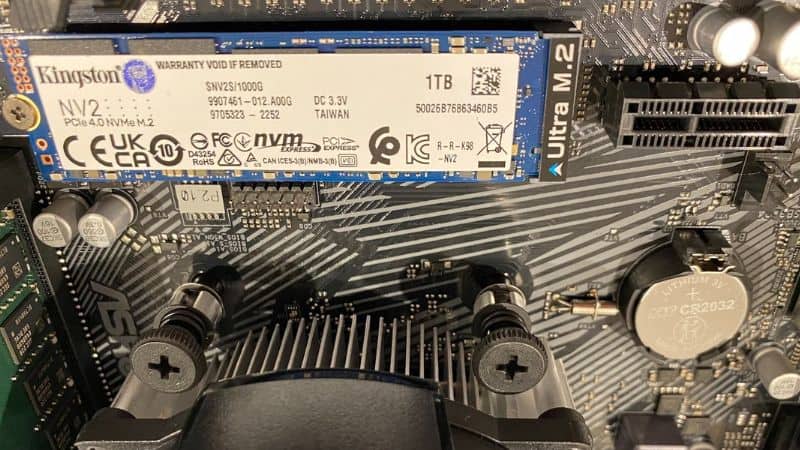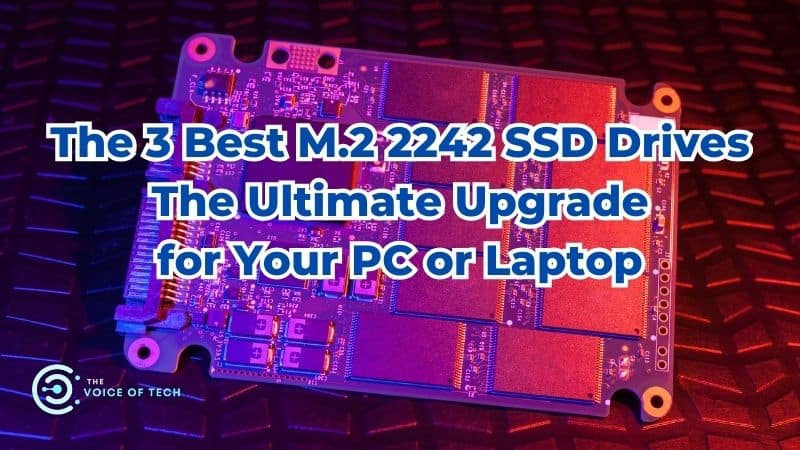
Expert Consulted: Adrian Gardiner. Years of experience buying both computers and computer parts for my own new customer builds has given me a keen eye for spotting great deals when shopping. In this article, I’ll be sharing my knowledge to help you find the best M.2 2242 SSD.
SSD drives and the M.2 format, in particular, are the storage drives to have these days, with their hugely improved performance, space-saving size, and many other benefits, and they come in a wide range of sizes to accommodate various requirements.
In this article, we’re looking mainly at the M.2 2242 SSD format and, in particular, the best models out there for purchasing in 3 different capacities: 256 GB, 512 GB, and 1 TB.
Related Articles:
Is a 500 GB SSD Good for Gaming?
SSD vs HDD – Are SSDs Faster for Your Gaming PC?
Why are SSDs So Expensive?
This post contains affiliate links; click here to read our affiliate policy.
M.2 2242 SSD Drives – An Overview

An M.2 SSD (solid state drive) is a storage device about the size of a stick of chewing gum (the 2280 size, at least) that’s designed to plug straight into the motherboard with no need for cables, brackets, etc. One of the smallest sizes is the M.2 2242 SSD drive, measuring only 42 mm long.
The M.2 (used to be called the NGFF or Next Generation Form Factor) SSD includes a range of sizes, but currently, most are 22 mm wide and available in 30, 42, 80, and 100 mm long variants.
These dimensions explain the numbering system used to describe each model, so you have the 2230 (22 wide x 30 mm long), 2242, 2280, and 22100 options.
The smaller sizes, 2230 and 2242, tend to be found in ultra-thin laptops (i.e., Microsoft Surface) and tablets where space is limited or used for embedded applications, etc. Larger sizes, in particular the 2280, are most often fitted to desktop computers and portable storage devices.
Some desktop computer motherboards also have slots for different sizes of M.2 SSD drives.
Capacity sizes range from 256 GB to 2 TB with the choice of Gen3 or Gen4 devices for the 2230 and 2242 and Gen 5 now available (but a bit more expensive) for the 2280.
| M.2 2242 SSD Option | Reason for Selection | |
| 1. | KingSpec SSD 256GB M.2 2242 SSD | 256 GB Option |
| 2. | SAMSUNG 512GB PM991 M.2 2242 SSD | 512 GB Option |
| 3. | SABRENT 1TB Rocket M.2 2242 SSD | 1 TB Option |
No. 1 – KingSpec 256GB M.2 2242 NVMe SSD – ‘256 GB Option’
The KingSpec 256GB M.2 NVMe SSD, designed with a 2242 PCIe Gen3x2 interface, is a high-performance and energy-efficient storage solution for laptops and desktops (where supported).
With low power consumption (max 2.0W) and 3D NAND TLC flash memory, this SSD delivers impressive read (up to 1100 MB/s) and write (up to 950 MB/s) speeds while maintaining stability and durability through features like bad block management, ECC, and S.M.A.R.T support.
It showcases broad compatibility, notably with devices like the Lenovo Thinkpad T470 and Huawei Matebook X.
With an MTBF of 1 million hours, this KingSpec SSD is a reliable, efficient, and robust choice for upgrading your computer’s storage.
Specification
- Form Factor: M.2 2242
- Interface: PCIe Gen 3
- Read Speed (Max): Up to 1100 MB/s
- Write Speed (Max): Up to 1000 MB/s
No. 2 – SAMSUNG 512GB PM991 M.2 2242 NVMe SSD – ‘512 GB Option’
The SAMSUNG 512GB M.2 2242 42mm PM991 NVMe PCIe Gen 4 x4 TLC SSD offers exceptional performance and design flexibility, making it an excellent storage solution for both laptops and desktops.
With its compact Ball Grid Array (BGA) packaging, it is power-efficient while delivering robust performance, making it a perfect fit for slimmer laptops and Ultrabooks.
Boasting a capacity of 512GB and an M.2 2242 PCIe NVMe form factor, this SSD ensures fast and reliable data storage.
Its compatibility extends beyond the 2242 size, as it can fit 2260 & 2242, and 2280 sizes with an adapter (not included), highlighting its adaptability.
In summary, Samsung’s PM991a is a high-performing, versatile, and compact SSD option, ideal for users seeking an upgrade in storage without sacrificing space or energy efficiency.
Specification
- Form Factor: M.2 2242
- Interface: PCIe Gen 4
- Read Speed (Max): Up to 2200 MB/s
- Write Speed (Max): Up to 1200 MB/s
No. 3 – SABRENT 1TB Rocket M.2 2242 NVMe SSD – ‘1 TB Option’
The SABRENT 1TB Rocket NVMe PCIe M.2 2242 DRAM-Less Low Power SSD (SB-1342-1TB) is a high-performance internal SSD that capitalizes on advanced flash disk technology.
With a PCIe Gen3 x4 interface, it meets the standard NGFF, boasting impressive speed performances of up to 2500MB/s read and 2100MB/s write, courtesy of Toshiba’s BiCS4 TLC NAND Flash memory.
In summary, this Sabrent SSD delivers both high performance and low power consumption, making it a solid, reliable choice for upgrading storage solutions.
This SSD excels in energy efficiency, consuming significantly less power than traditional hard drives, making it an excellent choice for eco-conscious users and new systems.
It is feature-rich, offering SMART and TRIM command support, advanced wear leveling, bad block management, and over-provision, along with upgradeable firmware.
Specification
- Form Factor: M.2 2242
- Interface: PCIe Gen 4
- Read Speed (Max): Up to 2500 MB/s
- Write Speed (Max): Up to 2100 MB/s
Before Making an M.2 2242 SSD Purchase
There are a few considerations worth taking note of before you decide to buy one of these M.2 2242 SSD drives:
- If buying a laptop, check carefully with the manufacturer to make sure that there is a suitably sized slot for this drive. Not all laptops will support it. However, it’s also worth noting that by using a special bracket/adapter, it’s possible to fit a 2242 drive into a 2280 slot – https://amzn.to/3slYEXq.
- If buying for a desktop, again, you’ll need to check the motherboard documentation to ensure that a) it fits and b) that installing it doesn’t affect something else in your system, like disabling SATA ports, for example.
- If purchasing a PCIe Gen 4 version M.2 2242 SSD, make sure first that the laptop definitely supports Gen 4 to avoid problems and to also make the most of the extra performance available.
This is especially true if you’re planning on upgrading from Gen3 to Gen4 on an older device to get more speed.
Frequently Asked Questions
Here are a few questions with answers that I get asked:
Q1 Do I need a professional to install my M.2 2242 SSD?
Not necessarily, but it really depends on where the SSD is being fitted. These drives typically are found in ultra-thin laptops and tablets, devices that aren’t that user-friendly for taking apart to fit new parts.
On the other hand, if you have a supported laptop or a PC motherboard that has a suitable slot for an M.2 2242 SSD, then yes, it’s very easy to fit.
Q2 Is it worth upgrading from a SATA SSD to an M.2 SSD?
Definitely worth considering as there is a significant performance boost from M.2 SSD drives compared to SATA SSDs. You’ll find booting up much quicker, plus opening programs and large files will also load up faster.
There is also a performance boost from Gen 3 to Gen 4 M.2 SSD drives, so if upgrading this will definitely be worth your while.
Q3 What’s the difference between NVMe and SATA in an M.2 SSD?
NVMe is the latest and much faster standard that makes full use of high-speed PCIe lanes, whereas SATA is an older and slower protocol initially designed for use with HDD (hard disk drives). NVMe is the way to go.
Conclusion
If you’re upgrading to an M.2 2242 SSD drive from an older SATA SSD or an ancient spinning disk HDD, then you’re going to see significant performance improvements that’ll make you wonder why you didn’t upgrade earlier.
Before upgrading, you’ll need to check carefully to ensure that a) the drive is the right choice for your particular hardware and b) it’s a drive that you can fit yourself without any issues.
Whether you’re upgrading just for faster performance or simply for more capacity with a larger drive, the M.2 2242 SSD and, indeed, any M.2 SSD model would be a great choice.



